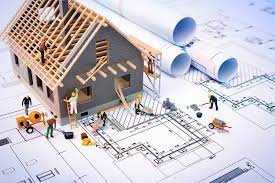A construction loan is a type of loan that is specifically designed for people who want to build a new home or renovate an existing one. The loan is different from a traditional mortgage because it is not given in a lump sum but rather is disbursed in increments as the construction project progresses. This allows borrowers to pay for materials and labor as they are needed, rather than having to come up with the entire cost of the project upfront.
Construction loans can be complex and often require a great deal of planning and preparation on the part of the borrower. In this article, we will discuss the basics of construction loans, including how they work, the types of construction loans available, and the pros and cons of using a construction loan to finance your building project.
How construction loans work:
Construction loans are typically short-term loans, usually lasting between 6 and 12 months. During this time, the borrower will make interest-only payments on the loan. Which will be based on the amount of money that has been disbursed so far. Once the construction is complete, the loan will typically convert to a traditional mortgage, or. The borrower may be required to refinance the loan.
To obtain a construction loan, borrowers will need to provide detailed plans for the project. Including architectural drawings, a budget, and a timeline for completion. The lender will use this information to determine how much money to lend and when to disburse the funds.
During the construction process, the lender will typically send out an inspector to verify that the work has been completed before releasing additional funds. This helps to ensure that the project is progressing according to plan and that the money is being used for its intended purpose.
Types of construction loans:
There are several types of construction loans available, each with its own set of advantages and disadvantages. Here are some of the most common types of construction loans:
Construction-to-permanent loan: This type of loan combines the construction loan and the mortgage into one loan. Which is typically easier and more convenient for the borrower. The loan is disbursed in increments as the construction project progresses, and once the construction is complete. The loan automatically converts to a traditional mortgage.
Stand-alone construction loan: This type of loan is used exclusively for the construction phase of the project and is paid off in full once the construction is complete. Once the construction is finished, the borrower will need to obtain a separate mortgage to pay off the loan. How Construction Loan Work
Renovation loan: This type of loan is used for major renovations or additions to an existing home. The loan is typically disbursed in increments as the work is completed. And the borrower may be required to provide detailed plans and cost estimates for the project. How Construction Loan Work
Pros and cons of using a construction loan:
There are several advantages to using a construction loan to finance your building project. For one, it allows you to pay for the project as it progresses. Rather than having to come up with the entire cost upfront. This can be especially helpful for those who are building a new home and do not have a lot of cash on hand.
Another advantage is that the loan is typically based on the completed value of the home, rather than the current value. This means that borrowers can often borrow more money than they would be able to with a traditional mortgage.
However, there are also some disadvantages to using a construction loan. For one, they can be more expensive than traditional mortgages, as they often come with higher interest rates and fees. Additionally, borrowers may be required to provide more detailed plans and documentation for the project, which can be time-consuming and costly.How construction loans work
Conclusion:
If you are considering building a new home or renovating an existing one. A construction loan may be a good option for you. However, it is important to do your research and understand the pros and cons of using it. A construction loan before committing to one. It is also important to have a solid plan in place for your construction project. Including a detailed budget, timeline, and architectural drawings. When selecting a lender for your construction loan. Be sure to shop around and compare rates and terms from multiple lenders. Look for a lender that specializes in construction loans and has experience working with borrowers in your situation.

